An Improved Automatic Algorithm for Global Eddy Tracking Using Satellite Altimeter Data
Abstract
:1. Introduction
2. Materials and Methods
2.1. Data
2.2. Eddy Detection
2.3. Eddy Tracking
- (i)
- Initialization: Initialize the global eddy tracks using the eddy cores identified in the first time step, t.
- (ii)
- Searching: Search for each eddy at time t; then, search for the next candidate eddies in the next time step (t+1) within a specific range. The search area is an “ellipse” with a zonally oriented major axis. The western boundary of the ellipse is the distance from the eddy core, which is determined from the maximum value between 1.75 times the daily long Rossby wave propagation distance [41] and the mean mesoscale eddy propagation distance on the order of 10 km per day [42,43]. However, since 150 km was set as the minimum search range for weekly data by Chelton et al. [2] and we used daily data, the maximum daily travel distance of an eddy should be approximately 21 km. Furthermore, the altimeter data resolution is approximately 25 km; the eddy might “jump” or “disappear” because of sampling errors and measurement noise [2]. Thus, we extended the minimum search range of the western, eastern, southern and northern boundaries to 50 km.
- (iii)
- Selecting: After setting the search range, a selection procedure is carried out. Eddies within the search range at time step t+1 are candidate eddies if their area and amplitude are between 0.25 and 2.75 times those of the current eddy. When candidate eddies exist, the HD is calculated between the boundary of each candidate eddy and the current eddy boundary, and the candidate eddy with the minimum HD is selected as the next eddy. To account for the transient “disappearance” of the mesoscale eddies from the sea surface, we also allow eddies to “disappear” for one time step while tracking. Meanwhile, we expand the search area based on the propagation distance. Of course, we could perform the calculation using a larger number of time steps, but that is not the point of this paper. When no candidate eddy exists at time step t+1, a similar selection process is conducted at time step t+2 to find the next eddy. When no eligible eddy can be found at time step t+1 or t+2, the track of this eddy is stopped at time t. During this procedure, the selected eddy is flagged as true, while non-selected eddies are flagged as false.
- (iv)
- Updating: We update the recorded tracks at time t with the next selected eddies. Subsequently, if some eddies are still flagged as false at time t+1, then new tracks are initiated with each of these eddies, repeating the preceding steps to complete the long time series tracking of global eddies until the property limitations are exceeded.
3. Global Long Time Series Comparison and Discussion
3.1. Validation
3.2. Eddy Frequency, Radius, Amplitude
3.3. Propagation
3.4. EddySources and Sinks
4. Conclusions
Acknowledgments
Author Contributions
Conflicts of Interest
References
- Bryden, H.L.; Brady, E.C. Eddy momentum and heat fluxes and their effects on the circulation of the equatorial Pacific Ocean. J. Mar. Res. 1989, 47, 55–79. [Google Scholar] [CrossRef]
- Chelton, D.B.; Schlax, M.G.; Samelson, R.M. Global observations of nonlinear mesoscale eddies. Prog. Oceanogr. 2011, 91, 167–216. [Google Scholar] [CrossRef]
- McGillicuddy, D.J.; Anderson, L.A.; Bates, N.R.; Bibby, T.; Buesseler, K.O.; Carlson, C.A.; Davis, C.S.; Ewart, C.; Falkowski, P.G.; Goldthwait, S.A.; et al. Eddy/wind interactions stimulate extraordinary mid-ocean plankton blooms. Science 2007, 316, 1021–1026. [Google Scholar] [CrossRef] [PubMed]
- Holloway, G. Estimation of oceanic eddy transports from satellite altimetry. Nature 1986, 323, 243–244. [Google Scholar] [CrossRef]
- McWilliams, J. Parameterizing eddy-induced tracer transports in ocean circulation models. J. Phys. Oceanogr. 1995, 25, 463–474. [Google Scholar]
- Stammer, D. On eddy characteristics, eddy transports, and mean flow properties. J. Phys. Oceanogr. 1998, 28, 727–739. [Google Scholar] [CrossRef]
- Morrow, R.; Fang, F.; Fieux, M.; Molcard, R. Anatomy of three warm-core Leeuwin Current eddies. Deep Sea Res. Part II Top. Stud. Oceanogr. 2003, 50, 2229–2243. [Google Scholar] [CrossRef]
- Volkov, D.L.; Lee, T.; Fu, L.L. Eddy-induced meridional heat transport in the ocean. Geophys. Res. Lett. 2008, 35. [Google Scholar] [CrossRef]
- Early, J.J.; Samelson, R.; Chelton, D.B. The evolution and propagation of quasigeostrophic ocean Eddies. J. Phys. Oceanogr. 2011, 41, 1535–1555. [Google Scholar] [CrossRef]
- Krauß, W.; Böning, C.W. Lagrangian properties of eddy fields in the northern North Atlantic as deduced from satellite-tracked buoys. J. Mar. Res. 1987, 45, 259–291. [Google Scholar] [CrossRef] [Green Version]
- Pingree, R. Winter warming in the southern Bay of Biscay and Lagrangian eddy kinematics from a deep-drogued Argos buoy. J. Mar. Biol. Assoc. UK 1994, 74, 107–128. [Google Scholar] [CrossRef]
- Crawford, W.R.; Whitney, F.A. Mesoscale eddy aswirl with data in Gulf of Alaska. Eos Trans. Am. Geophys. Union 1999, 80, 365–370. [Google Scholar] [CrossRef]
- Sadarjoen, I.A.; Post, F.H. Detection, quantification, and tracking of vortices using streamline geometry. Comput. Graph. 2000, 24, 333–341. [Google Scholar] [CrossRef]
- Wade, I.P.; Heywood, K.J. Tracking the PRIME eddy using satellite altimetry. Deep Sea Res. Part II Top. Stud. Oceanogr. 2001, 48, 725–737. [Google Scholar] [CrossRef]
- Puillat, I.; Letage, I.T.; Millot, C. Algerian eddies lifetime can near 3 years. J. Mar. Syst. 2002, 31, 245–259. [Google Scholar] [CrossRef]
- Fontanet, J.I.; Ladona, E.G.; Font, J. Identification of marine eddies from altimetric maps. J. Atmos. Ocean. Technol. 2003, 20, 772–778. [Google Scholar] [CrossRef]
- Penven, P.; Echevin, V.; Pasapera, J.; Colas, F.; Tam, J. Average circulation, seasonal cycle, and mesoscale dynamics of the Peru Current System: A modeling approach. J. Geophys. Res. Oceans 2005, 110. [Google Scholar] [CrossRef]
- Chaigneau, A.; Gizolme, A.; Grados, C. Mesoscale eddies off Peru in altimeter records: Identification algorithms and eddy spatio-temporal patterns. Prog. Oceanogr. 2008, 79, 106–119. [Google Scholar] [CrossRef]
- Chaigneau, A.; Eldin, G.; Dewitte, B. Eddy activity in the four major upwelling systems from satellite altimetry (1992–2007). Prog. Oceanogr. 2009, 83, 117–123. [Google Scholar] [CrossRef]
- Chen, G.; Hou, Y.; Chu, X. Mesoscale eddies in the South China Sea: Mean properties, spatiotemporal variability, and impact on thermohaline structure. J. Geophys. Res. Oceans 2011, 116. [Google Scholar] [CrossRef]
- Mason, E.; Pascual, A.; McWilliams, J.C. A new sea surface height–based code for oceanicmesoscale eddy tracking. J. Atmos. Ocean. Technol. 2014, 31, 1181–1188. [Google Scholar] [CrossRef]
- Chelton, D.B.; Schlax, M.G.; Samelson, R.M.; de Szoeke, R.A. Global observations of large oceanic eddies. Geophys. Res. Lett. 2007, 34. [Google Scholar] [CrossRef]
- Fontanet, J.I.; Ladona, E.G.; Font, J. Vortices of the Mediterranean Sea: An altimetric perspective. J. Phys. Oceanogr. 2006, 36, 87–103. [Google Scholar] [CrossRef]
- Doglioli, A.; Blanke, B.; Speich, S.; Lapeyre, G. Tracking coherent structures in a regional ocean model with wavelet analysis: Application to Cape Basin eddies. J. Geophys. Res. Oceans 2007, 112. [Google Scholar] [CrossRef]
- Xiu, P.; Chai, F.; Shi, L.; Xue, H.; Chao, Y. A census of eddy activities in the South China Sea during 1993–2007. J. Geophys. Res. Oceans 2010, 115. [Google Scholar] [CrossRef]
- Fontanet, J.I.; Lapeyre, G.; Klein, P.; Chapron, B.; Hecht, M.W. Three-dimensional reconstruction of oceanic mesoscale currents from surface information. J. Geophys. Res. Oceans 2008, 113. [Google Scholar] [CrossRef]
- Chaigneau, A.; Le Texier, M.; Eldin, G.; Grados, C.; Pizarro, O. Vertical structure of mesoscale eddies in the eastern South Pacific Ocean: A composite analysis from altimetry and Argo profiling floats. J. Geophys. Res. Oceans 2011, 116. [Google Scholar] [CrossRef]
- Dong, C.; Lin, X.; Liu, Y.; Nencioli, F.; Chao, Y.; Guan, Y.; Chen, D.; Dickey, T.; McWilliams, J.C. Three-dimensional oceanic eddy analysis in the Southern California Bight from a numerical product. J. Geophys. Res. Oceans 2012, 117. [Google Scholar] [CrossRef]
- Yang, G.; Wang, F.; Li, Y.; Lin, P. Mesoscale eddies in the northwestern subtropical Pacific Ocean: Statistical characteristics and three-dimensional structures. J. Geophys. Res. Oceans 2013, 118, 1906–1925. [Google Scholar] [CrossRef]
- Lin, X.; Dong, C.; Chen, D.; Liu, Y.; Yang, J.; Zou, B.; Guan, Y. Three-dimensional properties of mesoscale eddies in the South China Sea based on eddy-resolving model output. Deep Sea Res. Part I Oceanogr. Res. Pap. 2015, 99, 46–64. [Google Scholar] [CrossRef]
- Nencioli, F.; Dong, C.; Dickey, T.; Washburn, L.; McWilliams, J.C. A vector geometry-based eddy detection algorithm and its application to a high-resolution numerical model product and high-frequency radar surface velocities in the Southern California Bight. J. Atmos. Ocean. Technol. 2010, 27, 564–579. [Google Scholar] [CrossRef]
- Kurczyn, J.; Beier, E.; Lavín, M.; Chaigneau, A. Mesoscale eddies in the northeastern Pacific tropical-subtropical transition zone: Statistical characterization from satellite altimetry. J. Geophys. Res. Oceans 2012, 117. [Google Scholar] [CrossRef]
- Faghmous, J.H.; Frenger, I.; Yao, Y.; Warmka, R.; Lindell, A.; Kumar, V. A daily global mesoscale ocean eddy dataset from satellite altimetry. Sci. Data 2015, 2. [Google Scholar] [CrossRef] [PubMed]
- AVISO. SSALTO/DUACS User Handbook: (M) SLA and (M) ADT Near-Real Time and Delayed Time Products. Available online: http://www.aviso.altimetry.fr/fileadmin/documents/data/tools/hdbk_duacs.pdf (accessed on 23 February 2017).
- Remote Sensing Systems. Available online: http://www.remss.com/measurements/sea-surface-temperature (accessed on 23 February 2017).
- Liu, Y.; Chen, G.; Sun, M.; Tian, F. A Parallel SLA-Based Algorithm for Global Mesoscale Eddy Identification. J. Atmos. Ocean. Technol. 2016, 33, 2743–2754. [Google Scholar] [CrossRef]
- Segond, M. Algorithmes Bio-mimétiques pour la Reconnaissance de Formesetl’apprentissage. Ph.D. Thesis, Universite du Littoral, Calais, France, 8 December 2006. [Google Scholar]
- De Carvalho, F.D.A.; de Souza, R.M.; Chavent, M.; Lechevallier, Y. Adaptive Hausdorff distances and dynamic clustering of symbolic interval data. Pattern Recognit. Lett. 2006, 27, 167–179. [Google Scholar] [CrossRef]
- Huttenlocher, D.P.; Klanderman, G.A.; Rucklidge, W.J. Comparing images using the Hausdorff distance. IEEE Trans. Pattern Anal. Mach. Intell. 1993, 15, 850–863. [Google Scholar] [CrossRef]
- Qiang, H.Q.; Qian, C.H.; Gong, S.R. Similarity Measure for Image Retrieval Based on Hausdorff Distance. In Applied Mechanics and Materials; Trans Tech Publications: Zurich, Switzerland, 2014; Volume 635, pp. 1039–1044. [Google Scholar]
- Chelton, D.B.; Deszoeke, R.A.; Schlax, M.G.; El Naggar, K.; Siwertz, N. Geographical variability of the first baroclinic Rossby radius of deformation. J. Phys. Oceanogr. 1998, 28, 433–460. [Google Scholar] [CrossRef]
- Lentini, C.A.; Olson, D.B.; Podestá, G.P. Statistics of Brazil Current rings observed from AVHRR: 1993 to 1998. Geophys. Res. Lett. 2002, 29. [Google Scholar] [CrossRef]
- Zhang, W.Z.; Xue, H.; Chai, F.; Ni, Q. Dynamical processes within an anticyclonic eddy revealed from Argo floats. Geophys. Res. Lett. 2015, 42, 2342–2350. [Google Scholar] [CrossRef]
- Font, J.; Isert-Fontanet, J.; De Jesus Salas, J. Tracking a big anticyclonic eddy in the western Mediterranean Sea. Sci. Mar. 2004, 68, 331–342. [Google Scholar] [CrossRef]
- Xu, L.; Li, P.; Xie, S.P.; Liu, Q.; Liu, C.; Gao, W. Observing mesoscale eddy effects on mode-water subduction and transport in the North Pacific. Nat. Commun. 2016, 7. [Google Scholar] [CrossRef] [PubMed]
- Nan, F.; He, Z.; Zhou, H.; Wang, D. Three long-lived anticyclonic eddies in the northern South China Sea. J. Geophys. Res. Oceans 2011, 116. [Google Scholar] [CrossRef]
- Wooster, W.S.; Reid, J. Eastern boundary currents. Sea 1963, 2, 253–280. [Google Scholar]
- Heywood, K.J.; Somayajulu, Y.K. Eddy activity in the South Indian Ocean from ERS-1 altimetry. In Proceedings of the Third ERS Symposium on Space at the service of our Environment, Florence, Italy, 14–21 March 1997.
- Isoda, Y. Interaction of a warmeddy with the coastal current at the eastern boundary area in the Tsushima Current region. Cont. Shelf Res. 1996, 16, 1149–1163. [Google Scholar] [CrossRef]
- Morrow, R.; Birol, F.; Griffin, D.; Sudre, J. Divergent pathways of cyclonic and anti-cyclonic ocean eddies. Geophys. Res. Lett. 2004, 31. [Google Scholar] [CrossRef]
- Early, J.J. Mathematical Approaches to the Physics of Mesoscale Oceanography. Ph.D. Thesis, Oregon State University, 22 October 2009. [Google Scholar]
- Xu, C.; Shang, X.D.; Huang, R.X. Estimate of eddy energy generation/dissipation rate in the world ocean from altimetry data. Ocean Dyn. 2011, 61, 525–541. [Google Scholar] [CrossRef]
- Yang, H.; Wu, L.; Liu, H.; Yu, Y. Eddy energy sources and sinks in the South China Sea. J. Geophys. Res. Oceans 2013, 118, 4716–4726. [Google Scholar] [CrossRef]
- Zhai, X.; Johnson, H.L.; Marshall, D.P.; Wunsch, C. On the wind power input to the ocean general circulation. J. Phys. Oceanogr. 2012, 42, 1357–1365. [Google Scholar] [CrossRef]
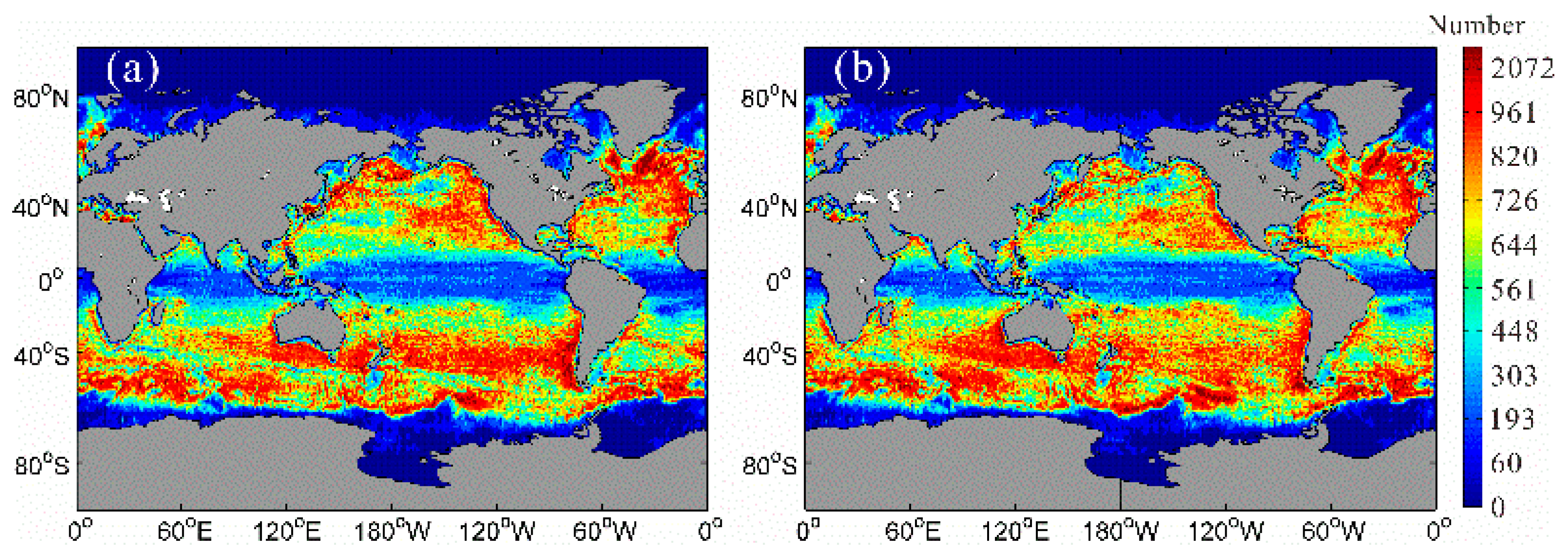

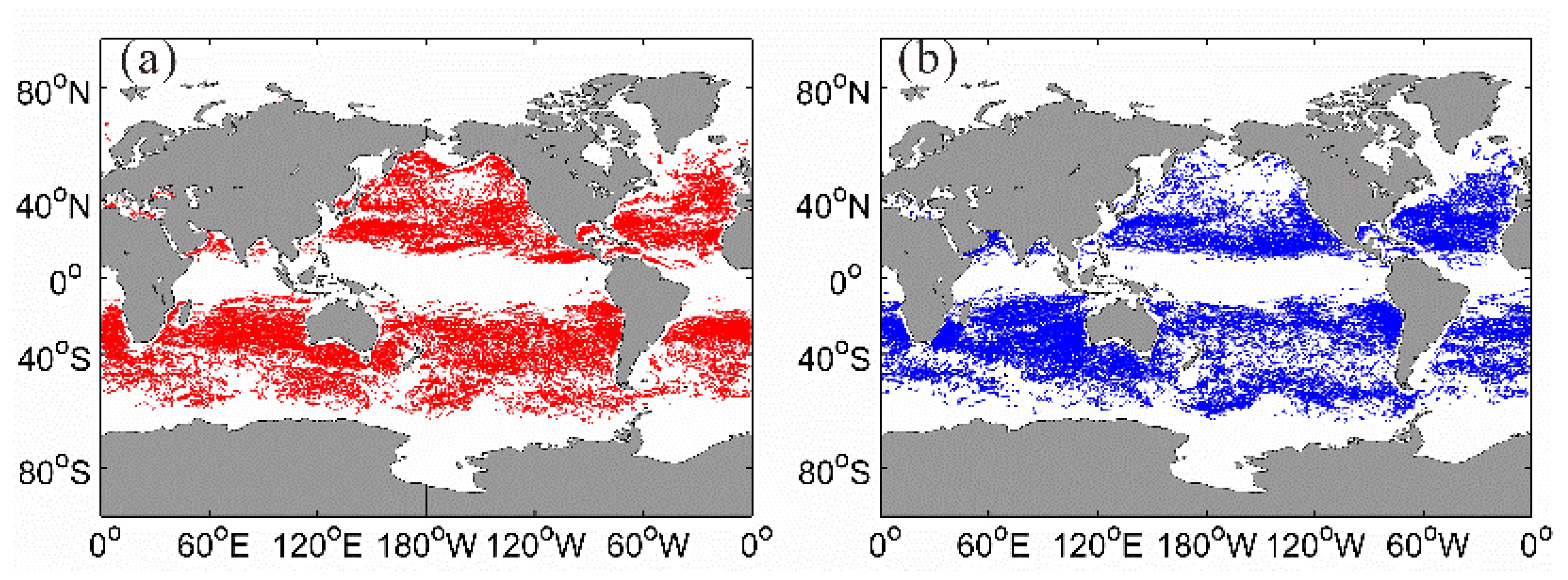
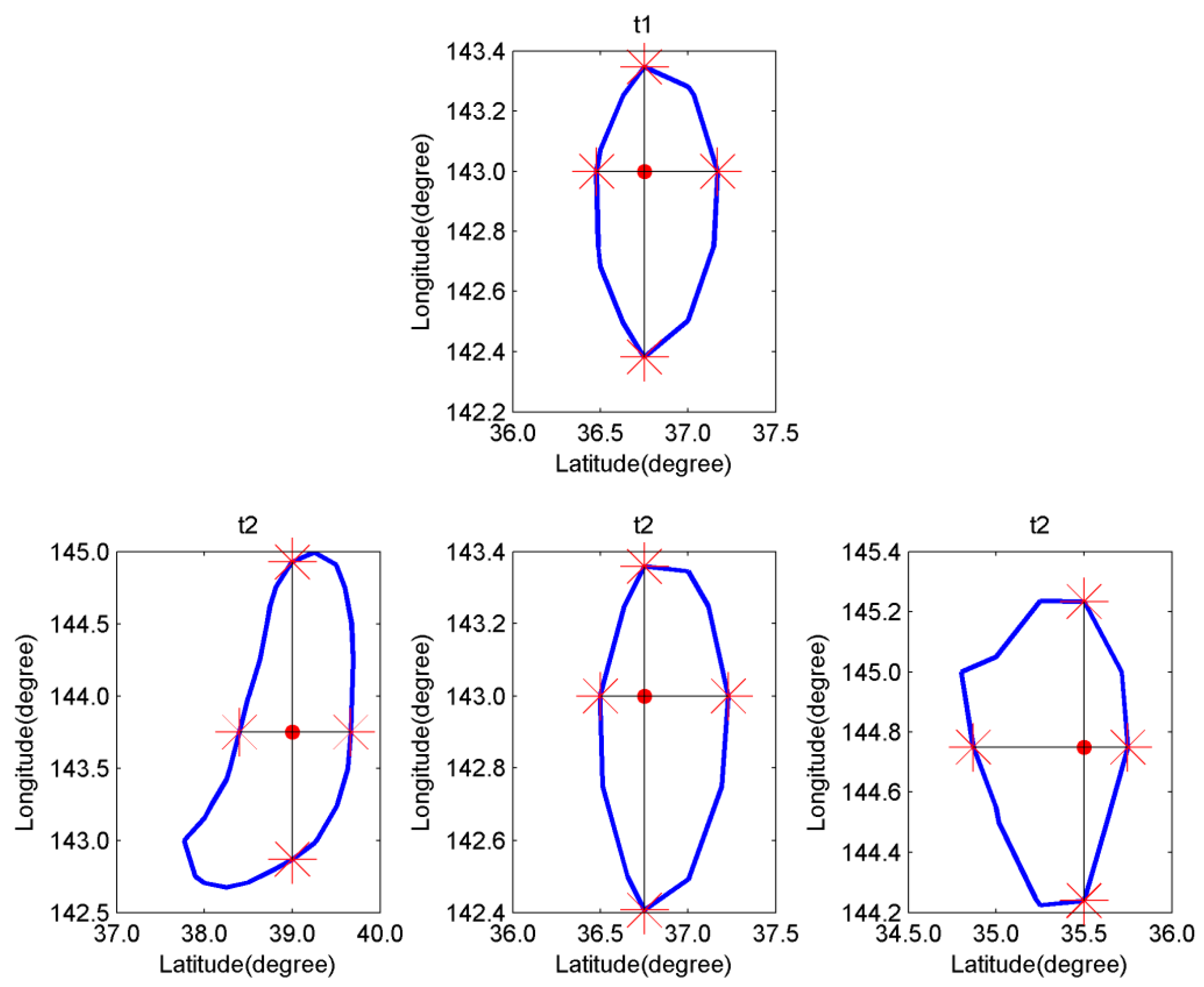
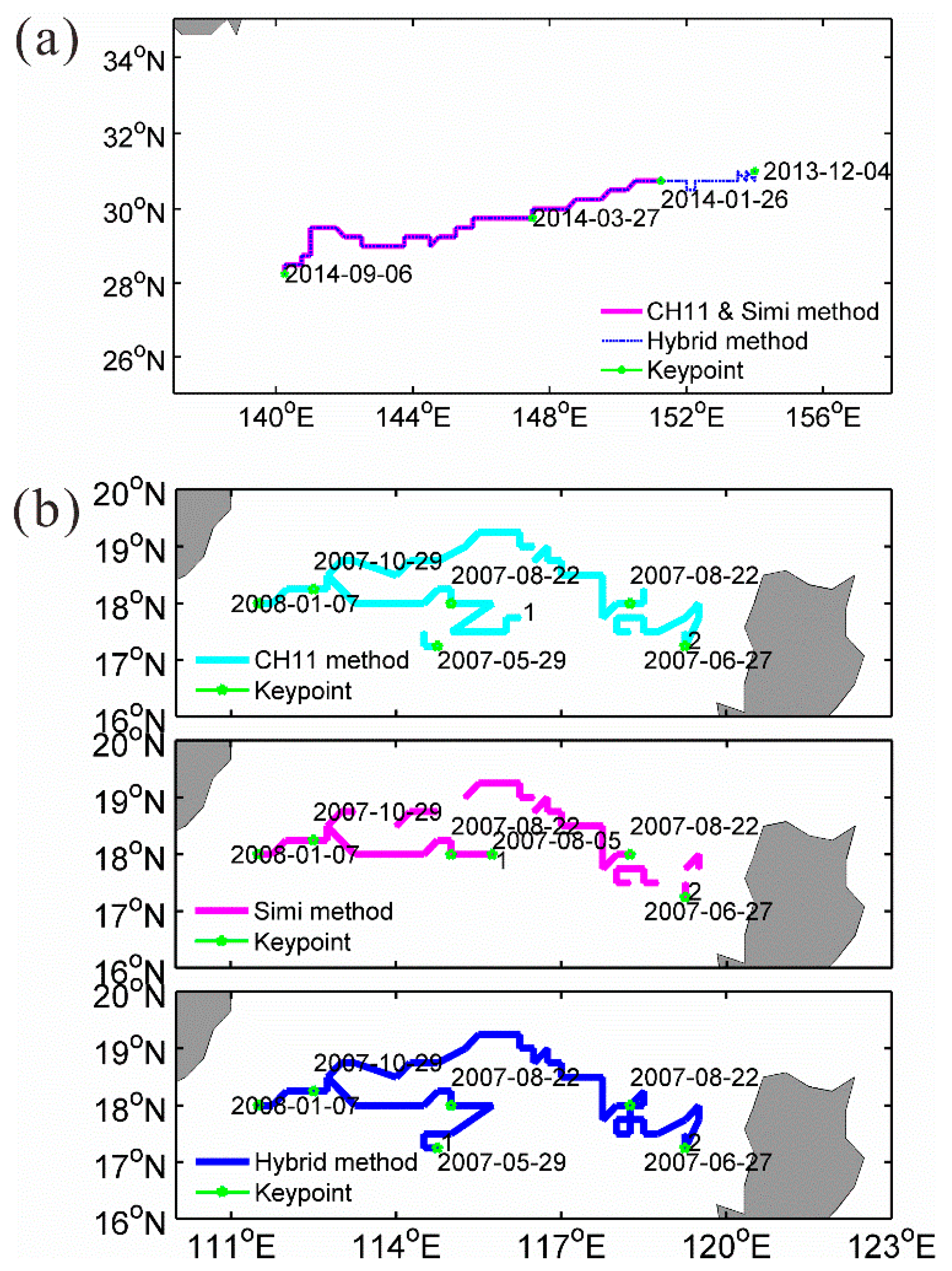
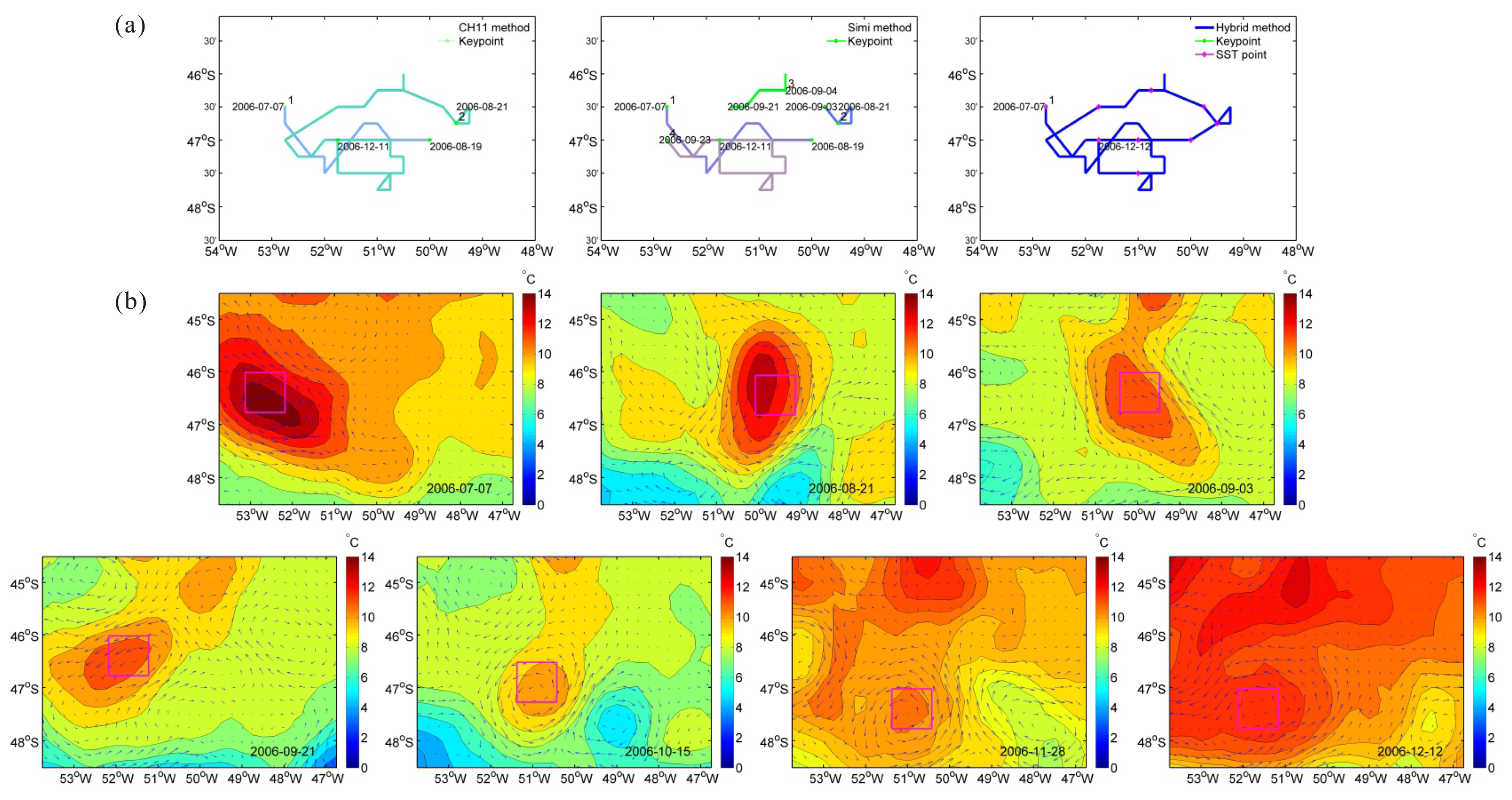
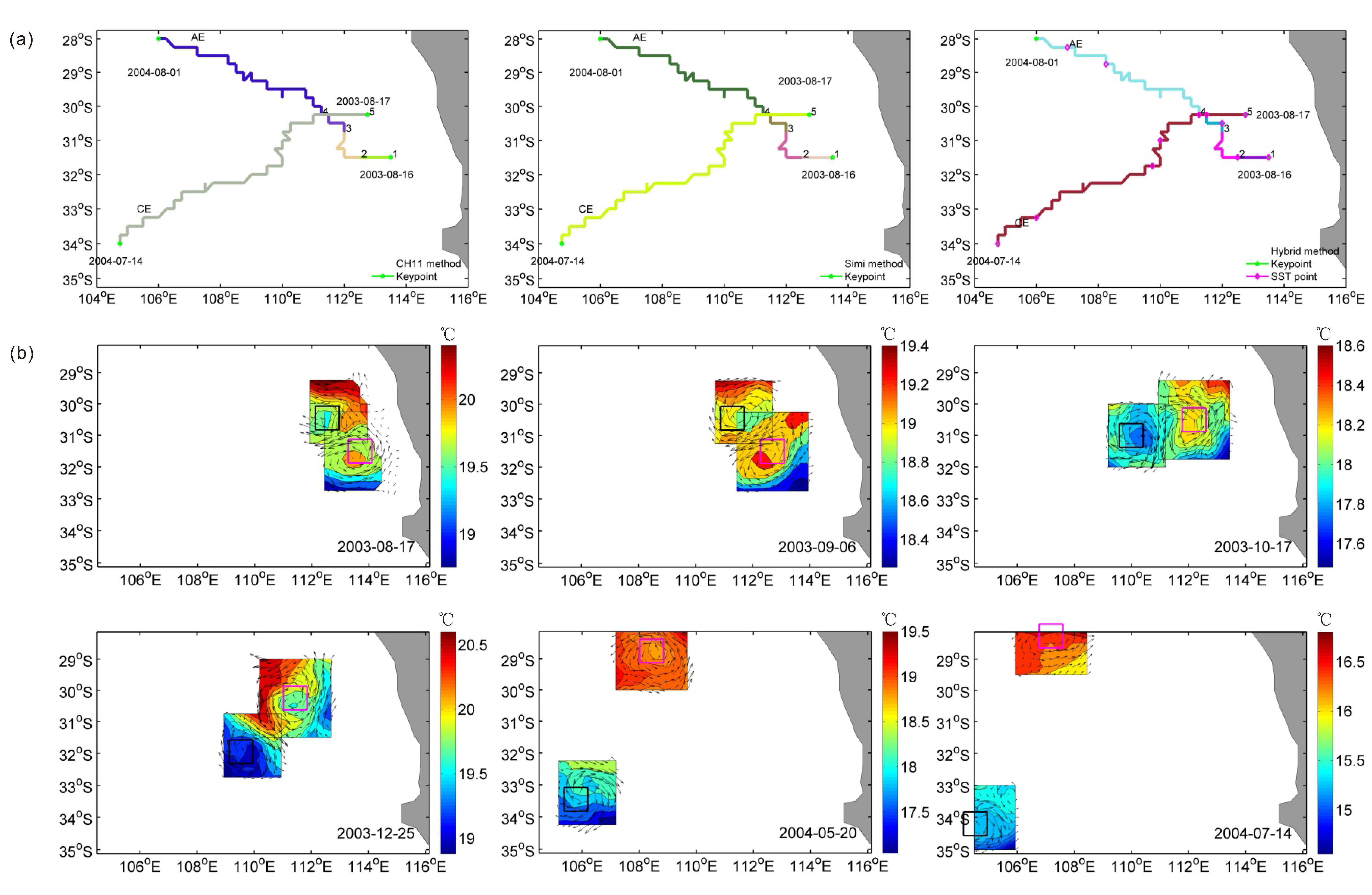
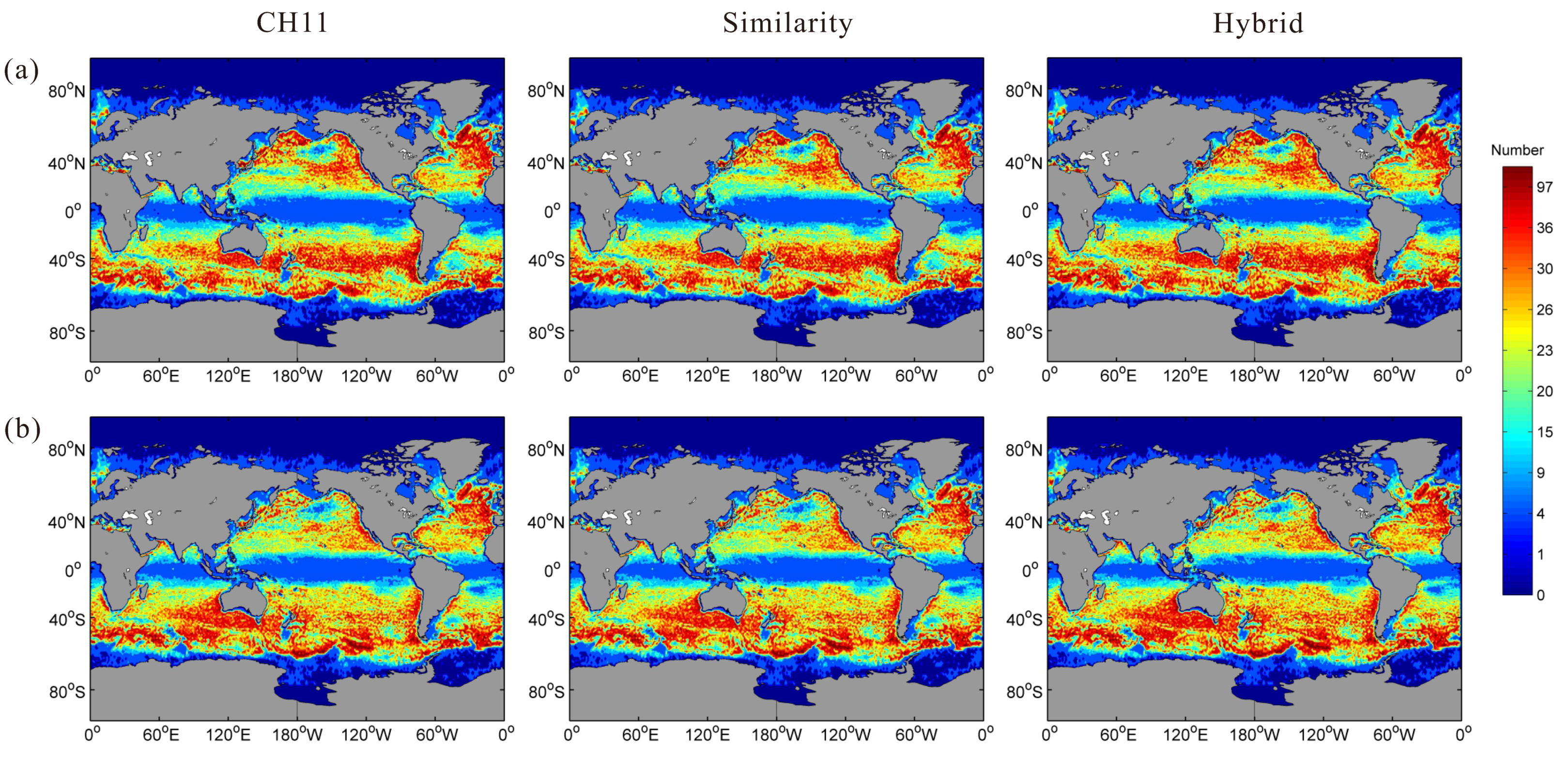

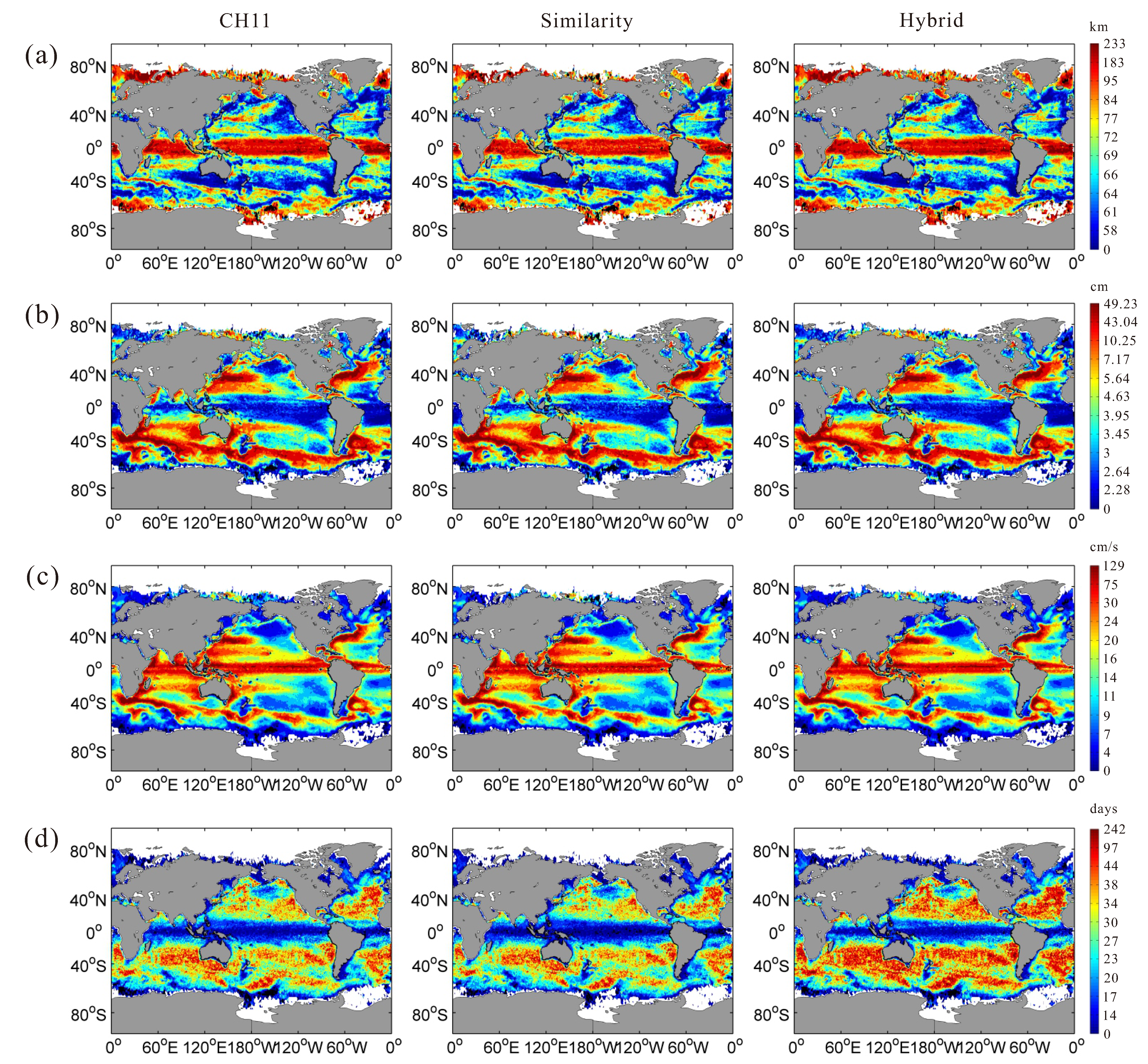
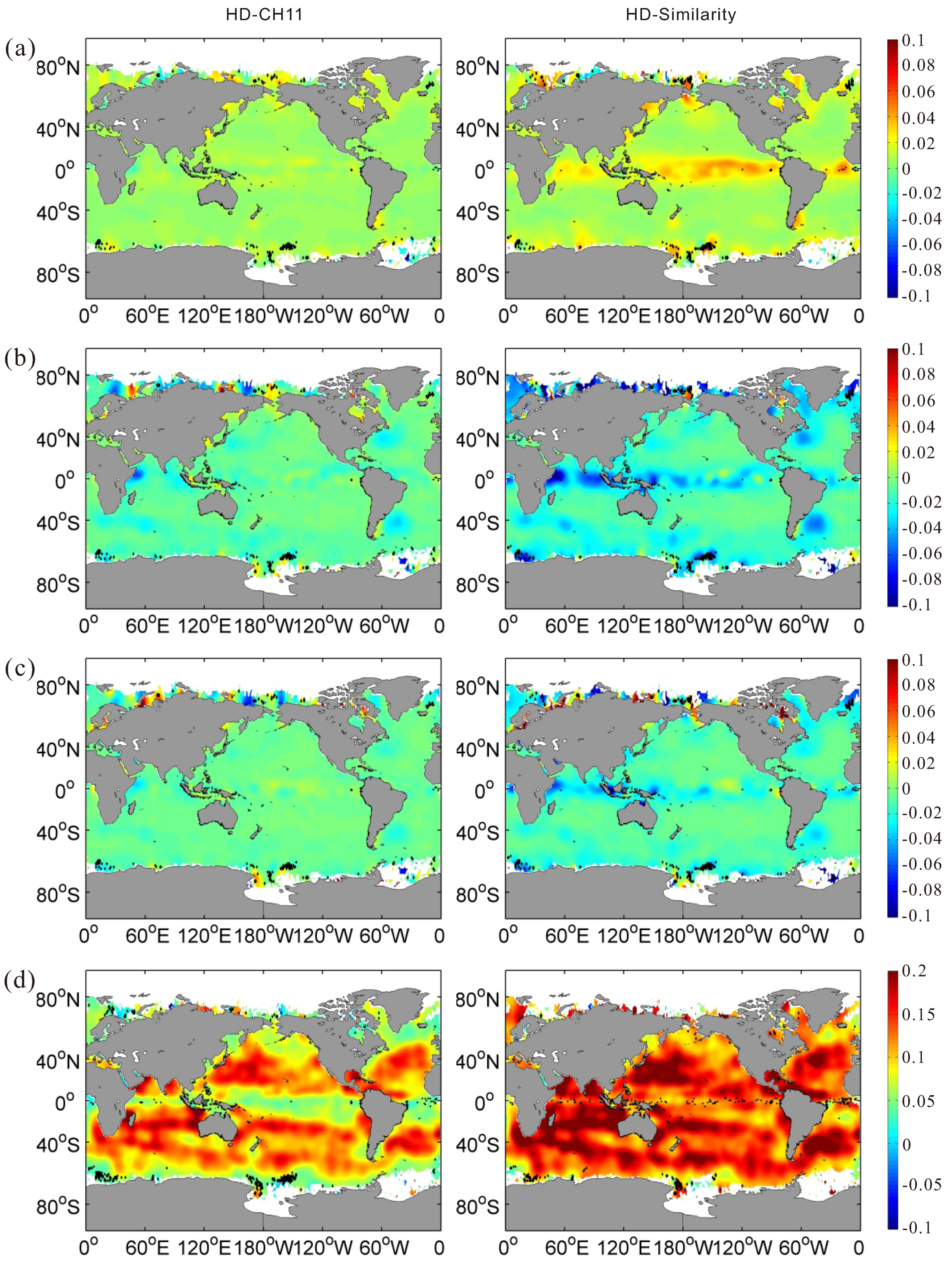
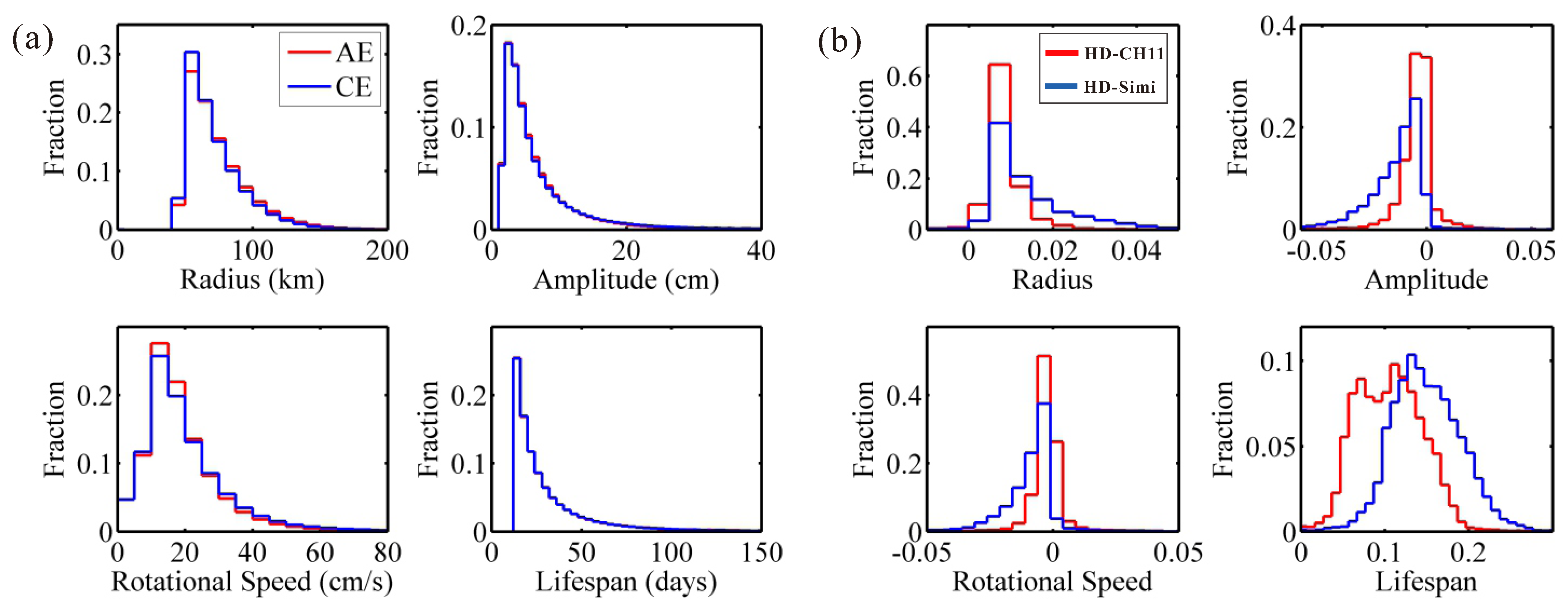

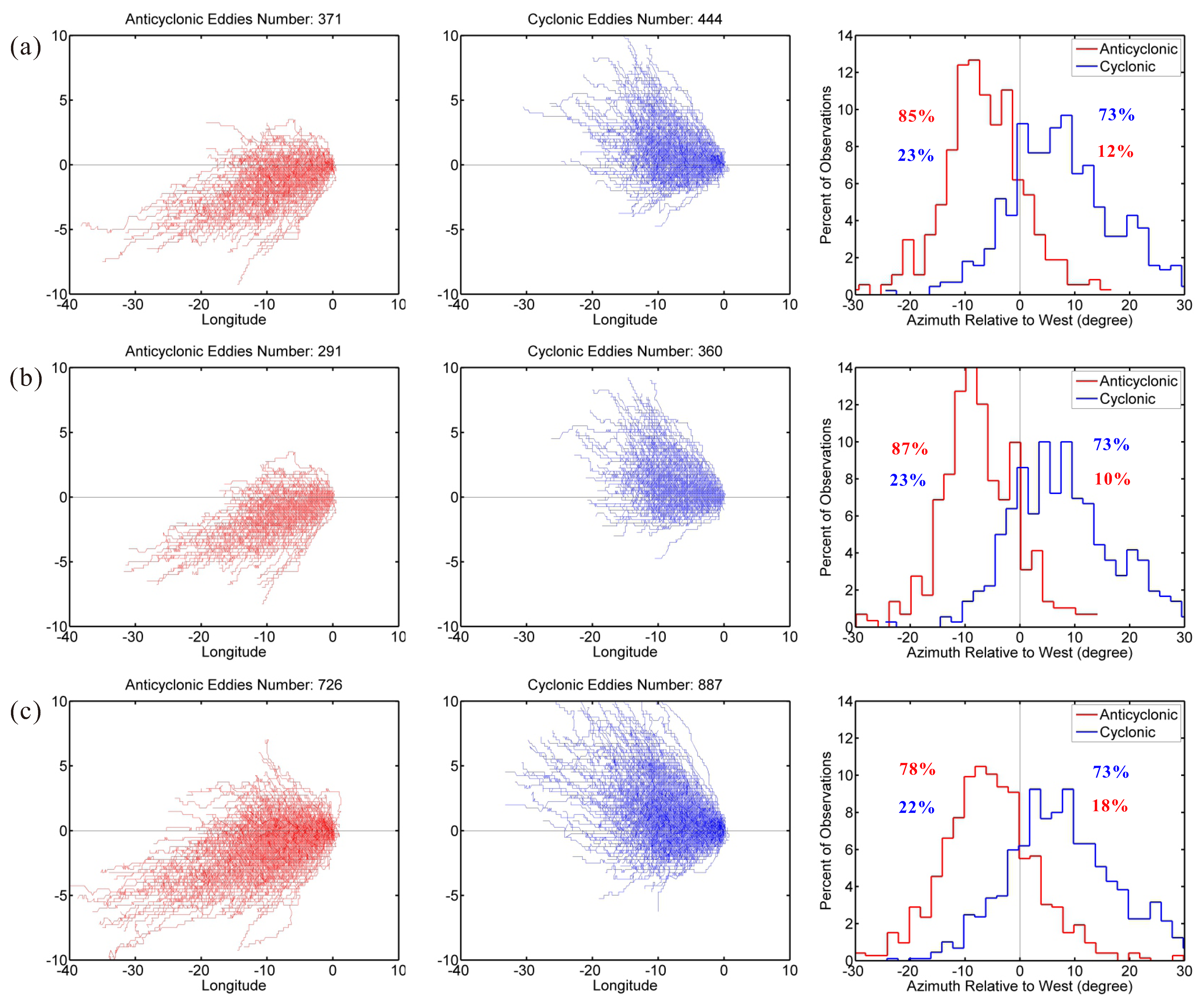
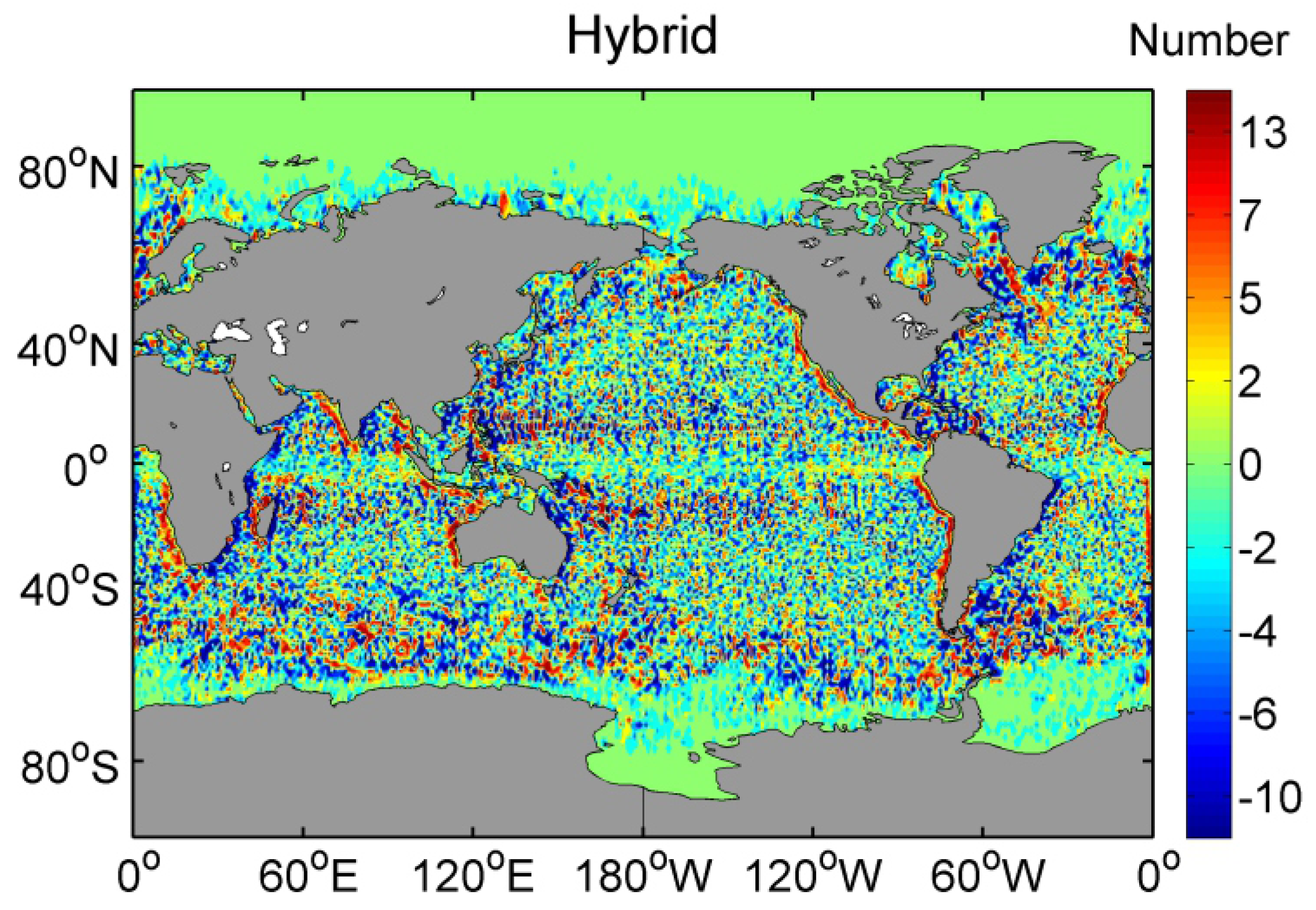
| Tracking Method | Track Number | Mean Lifespan (Days) | Max Lifespan (Days) | Mean Amplitude (cm) | Max Amplitude (cm) | Mean Radius (km) | Max Radius (km) | Mean Rotational Speed (cm/s) | Max Rotational Speed (cm/s) |
|---|---|---|---|---|---|---|---|---|---|
| CH11_CE | 552,310 | 28.7 | 853 | 5.5 | 98.4 | 67.0 | 246.6 | 16.2 | 162.5 |
| CH11_AE | 537,753 | 28.9 | 940 | 5.2 | 96.1 | 69.4 | 293.3 | 15.4 | 157.1 |
| Simi_CE | 552,217 | 28.7 | 853 | 5.9 | 78.1 | 68.8 | 245.9 | 16.6 | 150.8 |
| Simi_AE | 537,632 | 28.9 | 940 | 5.6 | 78.0 | 71.8 | 274.9 | 15.8 | 109.0 |
| Hybrid_CE | 528,916 | 31.3 | 1113 | 5.8 | 78.0 | 69.0 | 234.6 | 16.5 | 150.8 |
| Hybrid_AE | 512,444 | 31.7 | 1162 | 5.5 | 69.2 | 72.0 | 274.2 | 15.7 | 106.0 |
© 2017 by the authors. Licensee MDPI, Basel, Switzerland. This article is an open access article distributed under the terms and conditions of the Creative Commons Attribution (CC BY) license ( http://creativecommons.org/licenses/by/4.0/).
Share and Cite
Sun, M.; Tian, F.; Liu, Y.; Chen, G. An Improved Automatic Algorithm for Global Eddy Tracking Using Satellite Altimeter Data. Remote Sens. 2017, 9, 206. https://doi.org/10.3390/rs9030206
Sun M, Tian F, Liu Y, Chen G. An Improved Automatic Algorithm for Global Eddy Tracking Using Satellite Altimeter Data. Remote Sensing. 2017; 9(3):206. https://doi.org/10.3390/rs9030206
Chicago/Turabian StyleSun, Miao, Fenglin Tian, Yingjie Liu, and Ge Chen. 2017. "An Improved Automatic Algorithm for Global Eddy Tracking Using Satellite Altimeter Data" Remote Sensing 9, no. 3: 206. https://doi.org/10.3390/rs9030206
APA StyleSun, M., Tian, F., Liu, Y., & Chen, G. (2017). An Improved Automatic Algorithm for Global Eddy Tracking Using Satellite Altimeter Data. Remote Sensing, 9(3), 206. https://doi.org/10.3390/rs9030206






